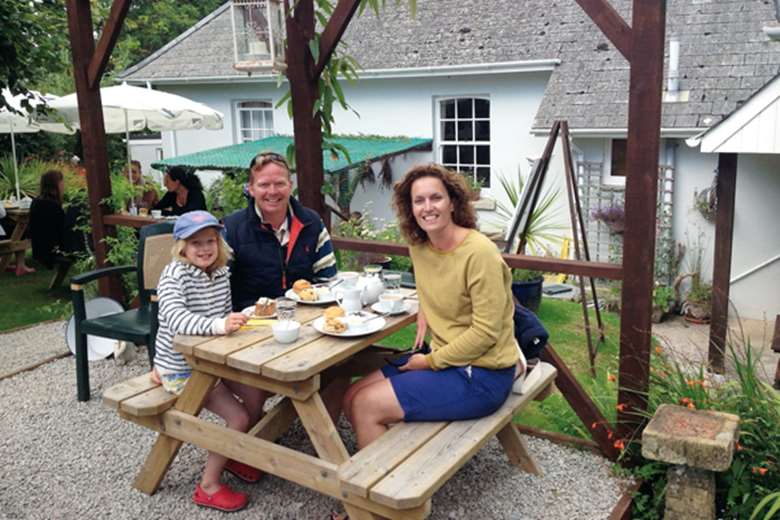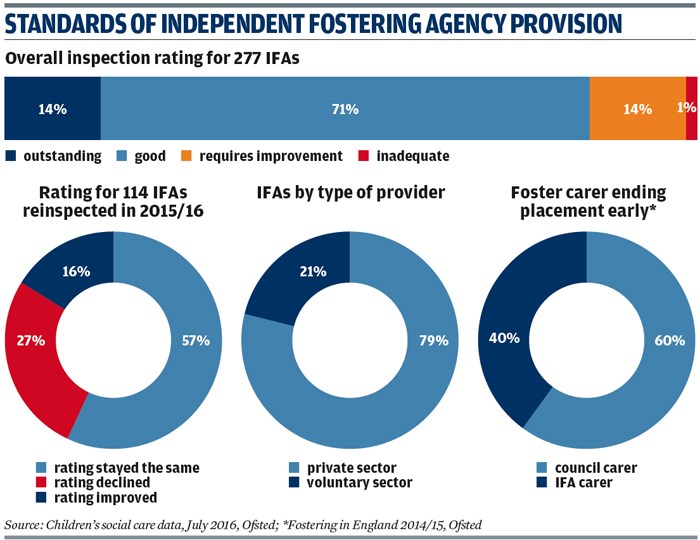Behind the Inspection Ratings: Independent fostering agencies
Jo Stephenson
Tuesday, July 19, 2016
Local authorities are increasing their use of independent fostering agencies to find loving homes for fostered children, but what does latest Ofsted data tell us about the standard of provision?

The majority of children in foster care are found placements by local authority fostering agencies. However, Ofsted data on fostering in England from 2014/15 showed the first signs that councils are increasing their use of independent fostering agencies (IFAs) - voluntary or private organisations that place children with foster carers on behalf of local authorities.
The increase in children placed through IFAs was higher than for those placed by local authority agencies, with 28,695 children found foster homes via IFAs in 2014/15, up by three per cent from 2013/14. Over the same period, the number of children placed by local authority fostering agencies increased by just one per cent, from 56,470 to 57,195.
Overall, the most recent breakdown shows about 67 per cent of foster children are in local authority placements and 33 per cent in placements with IFAs.
Ofsted inspection results are one way of judging the performance of fostering agencies. Latest published inspection data this month shows there were 297 IFAs operating in England as of March 2016, slightly down on 300 the previous year.
More than three quarters - 79 per cent - of IFAs were run by the private sector, while 21 per cent were voluntary providers. As of March 2016, Ofsted had inspected 277 of the 297 active IFAs and found "a very positive" picture, with 14 per cent rated "outstanding", 71 per cent "good", 14 per cent "requires improvement" and just one per cent "inadequate" (see graphics).
During 2015/16, a total of 139 inspections of IFAs were carried out. Nineteen IFAs - or 14 per cent - were rated outstanding, 69 per cent were judged good, 14 per cent require improvement and three per cent - four agencies - inadequate.
Of the IFAs inspected in the past year, 114 had been inspected before. The rating for more than half - 67 agencies - remained the same, with 96 per cent retaining a good or outstanding rating.
But there is evidence of a decline in standards: 14 per cent of agencies - 16 in total - had improved, while 27 per cent - 31 - had declined.
While Ofsted does not make a separate judgment on fostering agencies as part of local authority children's services inspections, its annual report on social care says evidence gathered by the regulator suggests the majority of local authority fostering services are performing well.
"Our evidence shows a largely positive picture of the support that foster carers receive from local authorities, with several outstanding examples of high-quality, innovative work," says the report. "As with independent fostering agencies, however, there is a small minority of local authorities that are failing to provide consistently the quality of training and support that all foster carers should expect and deserve."
Ofsted's Fostering in England report 2014/15 provides a more detailed picture of provision, including measures of children's experiences and outcomes that suggest differences in performance between local authority agencies and IFAs. However, some of these may be due to the characteristics of children being placed and the picture is mixed.
Stability is vitally important for looked-after children and a key measure relates to unplanned endings of foster placements, which can be distressing and disruptive. There were 7,245 unplanned endings overall in 2014/15 affecting up to eight per cent of all placed children. These cases were almost equally split between children placed by local authorities and by IFAs.
However, there were significant differences in when abrupt endings occurred.
One fifth happened within 24 hours of the placement starting and almost two-thirds of these moves were with local authority fostering agencies.
For almost half the children who experienced unplanned endings, the placement was halted at the request of the foster carer, which could be down to factors including not having enough information about a child's needs (see case study). In about 60 per cent of these cases, the children had been placed by local authorities, while 40 per cent were placed via IFAs.
Another measure is the use of physical restraint, with 1,025 incidents in 2014/15 involving 570 children and young people.
Almost three-quarters of the children reported to be subject to restraint were placed through IFAs, which may reflect independent agencies' work with more challenging children.
The number of incidents of restraint reported by IFAs decreased by 17 per cent from 2013/14 to 2014/15. This was a reversal from 2012/13 to 2013/14, when the number rose by 18 per cent.
Another potential indicator of the success of placements is whether young people stay on after the age of 18 under so-called "Staying Put" arrangements.
In 2014/15, the data shows young people placed through IFAs were more likely to leave than remain with their carer. However, this was not the case in the past three years, with young people placed through IFAs more likely to "stay put".
The number of young people who stayed in their local authority foster placement after turning 18 increased by three per cent from 1,215 to 1,255 with 56 per cent "staying put".
Meanwhile, the number of young people placed by IFAs who stayed in their placement after turning 18 remained the same, although it fell as a proportion of all young people from 54 to 45 per cent.
Agency meets needs ‘exceedingly well'
ABC Fostering Services | West Midlands | Outstanding | January 2016
Independent fostering agency ABC Fostering Services based in the West Midlands has around 60 foster households on its books, caring for about 75 children.
Its latest Ofsted inspection report found children and young people, including those with the most complex needs, "have their individual needs met exceedingly well".
"The two things that make a successful fostering service are getting the right people and getting the matching right, so we spend a lot of time thinking about the recruitment process," says Nick Dunster, ABC managing director.
At ABC, a supervising social worker assesses new carers, helps match children to them and also provides their ongoing support. Getting to know carers really well and building trust and understanding is vital, and helps make better matches, says Dunster.
"We made a match for a young person who likes car boot sales with a carer who is also into that," he explains.
"That detail probably didn't feature in the formal assessment and won't feature in any regulations, but actually a little hook between a child and foster carer is useful to know."
Detail is also important when assessing the wellbeing and happiness of children and young people. On top of the information it records for statutory purposes, the agency also gathers much of its own - "stuff I would want if it was my child", says Dunster.
This includes whether children know how to swim, have a bike and know how to ride it, and have been on a proper holiday in the past year.
ABC also asks whether children understand why they are in care. "This is quite a big question and can be difficult to answer, but it is really important if you're going to help a child grow up with positive self-regard and self-esteem," says Dunster.
ABC "provides very high quality ongoing support to carers", concludes Ofsted. "We're asking foster carers to take on a lot of unknowns and risk into their house. We do the opposite of dropping the child at the door and running for the hills," says Dunster. "We want carers to feel part of a team and know they can call us day or night."
About 42 per cent of children placed by ABC live with their brothers and sisters, compared to a 10 per cent national average. The fact carers feel able to manage sibling groups is testament to their confidence in the quality of support they will get, says Dunster.
The agency - which uses the "secure base" model developed at the University of East Anglia to underpin its approach and training for carers - also has a higher than average proportion of young people staying with foster families when they turn 18.
Dunster maintains that ABC "doesn't hang about if we identify an issue" such as a child with emotional or mental health problems. The agency has a good relationship with a local psychotherapy service which means assessments and direct work can be set up within weeks, avoiding long waits for overwhelmed child and adolescent mental health services, he explains.
Occasionally, placements break down, but ABC always tries to ensure a planned move. "The nightmare for me is an abrupt move or unexpected move," says Dunster. "Every time I have a move, I have an end-of-placement meeting with the carer to see if there is anything ABC, the local authority and the carer can learn."




